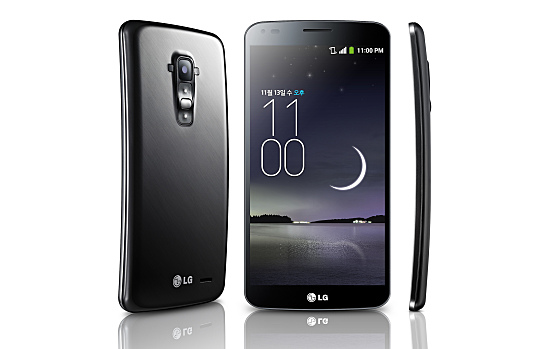On Monday, October 28, 2013, LG announced the upcoming release of the new G Flex smartphone. The device will feature a vertically curved screen, rather than the horizontally curved screen of Samsung’s Galaxy Round.
The press release claims that the curved screen of the LG G Flex is more comfortable for phone calls, as it more closely matches the shape of the average face. Additionally, the screen will provide better video viewing, described by LG as an “IMAX-like experience.” LG also cites comfort when storing the phone in a rear pocket as a benefit of the curve; however, the increased bulge of storing a device with this shape in a front pocket is not discussed.
The self-healing coating is another highly touted innovation of the LG G Flex. Supposedly capable of repairing nicks and scratches within minutes, the coating on the back cover will maintain a shiny new appearance longer. The protective coating is only used on the back and edges of the phone — the screen may still suffer from scratching much like any other mobile device.
The G Flex will be available starting in November, though only in the South Korean market, on all three major South Korean wireless carriers. Availability dates for other markets have yet to be announced.
With a six-inch, 1,280×720 pixel screen, the LG G Flex fits into the emerging category of “phablets,” the label being a portmanteau of the words smartphone and tablet that describes devices that fulfill the functions of both. Despite the large screen, the device weighs only 177 grams (6.2 ounces), thanks to its thin width (0.31 to 0.34 inches).
The device contains a powerful 13 megapixel camera, plus a 2.1 megapixel front-facing camera. With a 2.26-GHz quad-core Qualcomm Snapdragon 800 processor, the G Flex runs the newest Google Android operating system, Jelly Bean 4.2.2. It has 2GB of RAM and 32GB of memory.
The screen offers split windows for multitasking. The smartphone includes many well-received features and several new innovations to improve the user experience, particularly for media access and playback.
To allow for the curve, the LG G Flex utilizes a P-OLED (plastic organic light-emitting diode) screen. Additionally, the curved battery required significant hardware innovation. LG claims that the new technology required to make the curved battery actually increases battery performance.
Is the curved smartphone trend just a gimmick, or will the new curved screen technology actually improve the user interface and experience?
Image courtesy of Flickr
[cf]skyword_tracking_tag[/cf]

